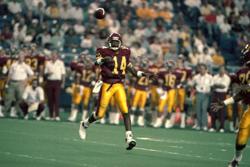
Rickey “Sweet Feet” Foggie is still a Gophers fan favorite.
The Career That Was is a new GopherHole series dedicated to digging up the professional careers, both major and minor, of former Gophers players. We have already taken a look at the career of Courtney James and Walter Bond. Have a Gopher with a pro career you want to see written up here? Tell me about it in the comments below.
When Lou Holtz left Arkansas following the 1983 season, one of his first moves as coach of the 1-10 Gophers was to recruit an All-State option quarterback out of Waterloo, South Carolina. Rickey Foggie came in as a true freshman starter and did nothing short of lead the team in rushing and passing as the Gophers improved to 4-7.
Foggie’s sophomore season saw the Gophers improve to 7-5 and a spot in the Independence Bowl against Clemson, the first time since 1977 the team had either a winning season or bowl appearance. With Holtz having abandoned the team before the game to coach at Notre Dame, Foggie, who grew up about 50 miles from Clemson, led two drives with his legs and arm in the final eleven minutes of the game. He ran three times for 30 yards and completed a crucial 22-yard pass on third-and-eleven, to set up Chip Lohmiller’s game-tying field goal, before Valdez Baylor’s one-yard run gave the Gophers the come from behind victory.
The winter after his sophomore year, Foggie suffered a pair of stress fractures in his lower legs playing a pick up game—Foggie was also an All-State basketball player—but returned in time to lead the team to a season-opening victory over Bowling Green. With freshman Darrell Thompson in the fold, the Gophers defeated #2 Michigan in Ann Arbor and finished the season with a loss to Tennessee in the Liberty Bowl, just the second time in school history that the Gophers made a bowl appearance in consecutive years. Foggie’s final season saw the Gophers begin 1987 with five consecutive victories before finishing 6-5.
Foggie finished his career at Minnesota at or near the top in a number of statistical rushing and passing categories, and defined an era for many fans in which the Gophers returned to national relevance.
The Career That Was
There were a number of NFL teams interested in drafting Foggie as a running back or wide receiver out of college, but the general mindset at the time was that Foggie’s skill set as a dual-threat quarterback wouldn’t jibe with NFL offenses. Foggie balked at changing positions, held true to his belief that he was a quarterback, and was bypassed in the 1988 NFL draft.
Instead, Foggie signed on with the British Columbia Lions of the Canadian Football League, where was a backup for his first two-plus seasons. Released in August of 1990, Foggie was immediately snatched up by the Toronto Argonauts where he became the starter, set a record for most 100-yard rushing games by a quarterback, and won the Grey Cup in 1991. Furing the following offseason, a 14-player blockbuster trade landed him with the Edmonton Eskimos. Although he won the Grey Cup again in his first season with Edmonton, for the next two seasons Foggie was once again a backup.
After being released by the Eskimos, Foggie was signed as a backup by the expansion Memphis Mad Dogs, then was drafted by Montreal in Alouettes the following season in the ninth round of the dispersal draft. He never played for the team, and Foggie instead signed on with the Minnesota Fighting Pike of the Arena Football League. Foggie, Mike Vanderjagt and the rest of the Fighting Pike went 4-10 and did not win a home game in their lone season of operation.
Foggie returned to the CFL in 1997 to play with the Hamilton Tiger Cats, but finished out the year back in the AFL with the expansion New Jersey Red Dogs. In New Jersey, Foggie was again a starter for two-plus seasons before losing his job to Tommy Maddox. The next two seasons, Foggie had stops with the AFL’s Florida Bobcats, Detroit Fury and Toronto Phantoms, until a rash of injuries caused Foggie’s original CFL team, British Columbia, to come calling on their 36-year-old former backup.
Foggie sat out 2003 to take an assistant coaching job at Augsburg, before returning at age 38 for a final professional season as the quarterback of the Carolina Cobras of the AFL in 2004.
Over the next five seasons, for five different teams in four different leagues, Foggie coached and acted as offensive coordinator, first in the Intense Football League, then the National Indoor Football League, the af2—the AFL’s minor league—and with the Kansas City Brigade of the AFL, where he was the offensive coordinator for starting quarterback Quincy Carter.
Foggie’s next coaching stop would bring him back to Minnesota, when he took over as offensive coordinator of the Burnsville Blaze in 2008. Three years later, he became the head football coach of Park Center High School.
Although he never played in the NFL, Foggie nonetheless put together a 16-year professional football career and played in three Grey Cups, winning the CFL title twice. He played or coached football at three different amateur levels and in five different professional leagues, and did so in Minnesota at the high school, collegiate and professional levels. And he’s not done. I can’t wait to see where Rickey Foggie’s football odyssey takes him next.
Ben Noble is a U of M graduate and Minneapolis-based writer, editor and photojournalist. You can follow the Twins with him here and follow him on Twitter at @TheBenNoble.